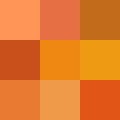See also
Color topics | ||||||||||
|---|---|---|---|---|---|---|---|---|---|---|
| Color science |
| |||||||||
| Color philosophy |
| |||||||||
| Color terms |
| |||||||||
| Color organizations | ||||||||||
| Names |
| |||||||||
| Related | ||||||||||
Color classifications | |
|---|---|
| Color systems, standards and palettes |
|
| Color names (alphabetic) | |
| Variations of base colors | |
This article includes a list of lists.





